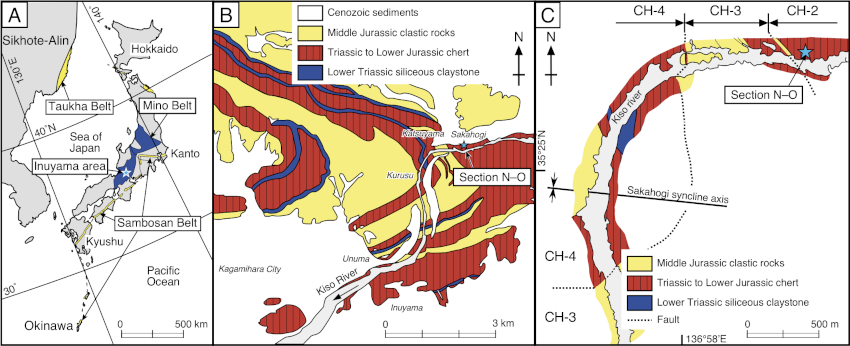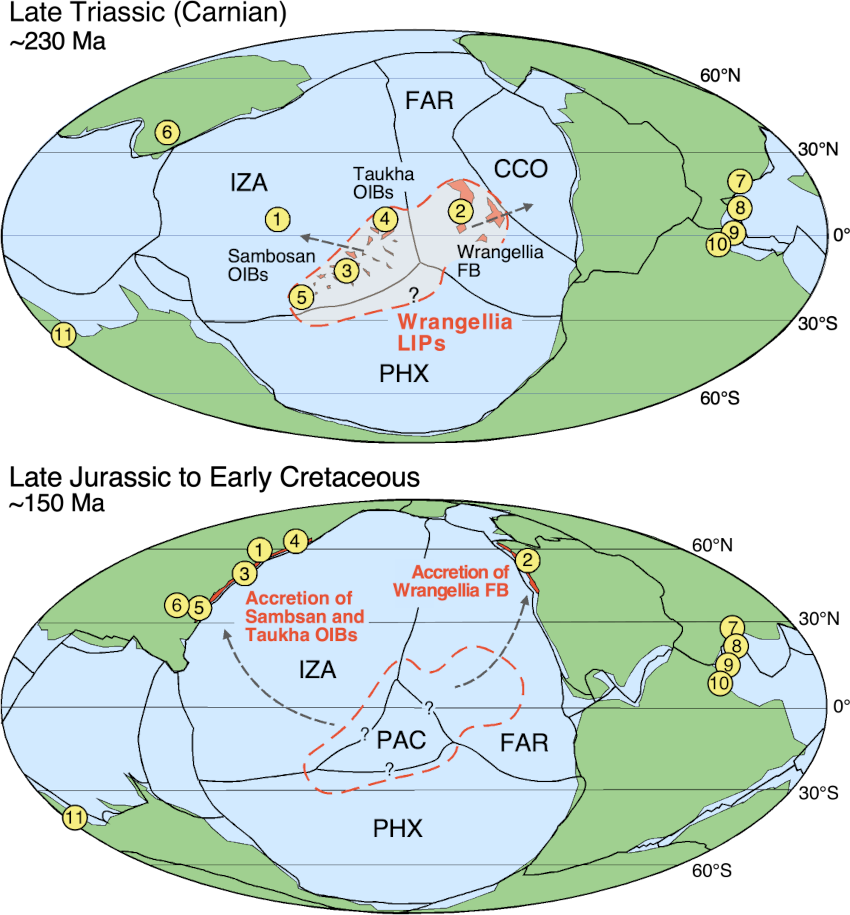August 2022 LIP of the Month
Linkage between Carnian Pluvial Episode and Wrangellia Large Igneous Province
Yuki Tomimatsu1, Honami Sato1, Tomonari Kandabashi1, Manuel Rigo2, Tetsuji Onoue1
1 Department of Earth and Planetary Sciences, Kyushu University, Fukuoka 812-8581, Japan
2 Department of Geosciences, University of Padova, Padova 35131, Italy
Extracted from:
Tomimatsu, Y., Nozaki, T., Sato, H., Takaya, Y., Kimura, J.–I., Chang, Q., Naraoka, H., Rigo, M., Onoue, T., 2021. Marine osmium isotope record during the Carnian “pluvial episode” (Late Triassic) in the pelagic Panthalassa Ocean. Global Planet. Change 197, 103387. https://doi.org/10.1016/j.gloplacha.2020.103387.
Tomimatsu, Y., Onoue, T., Rigo, M., 2022. Conodont and radiolarian biostratigraphic age constraints on Carnian (Upper Triassic) chert-hosted stratiform manganese deposits from Panthalassa: Formation of deep-sea mineral resources during the Carnian pluvial episode. Marine Micropaleontology 171, 102084. https://doi.org/10.1016/j.marmicro.2021.102084.
The Carnian Pluvial Episode (CPE) was a global environmental change and biotic crisis that occurred during the Carnian (237.0–220.4 Ma) in the Late Triassic. The climate during the CPE was characterized by a short-lived period of extreme rainfall, and major extinctions of marine taxa occurred in the Carnian (e.g., Simms and Ruffell, 1989). The Carnian is subdivided into two substages, which are the Julian and Tuvalian, and the extinctions of marine taxa are known to have occurred during the latest Julian (Dal Corso et al., 2020).
Although the cause of the CPE remains debated, a large volcanic event, such as the eruption of the Wrangellia Flood Basalt (FB), has been suggested as the most plausible trigger (Furin et al., 2006; Dal Corso et al., 2020). The Wrangellia FB today crops out in northwestern America, from Vancouver Island (Canada) to Alaska, and is estimated to have erupted at least 1 million km3 of basalts (Jones et al., 1977; Greene et al., 2010). Previous U–Pb geochronological studies have yielded Wrangellia FB ages of 227.3 ± 2.6, 226.8 ± 0.5, 228.4 ± 2.5, and 232.2 ± 1.0 Ma (Mortensen and Hulbert, 1992; Parrish and McNicoll, 1992; Greene et al., 2010), and 40Ar/39Ar ages of the Wrangellia FB range from 233–227 Ma (Greene et al., 2010). The eruption age of the Wrangellia FB is constrained to middle Ladinian to early Tuvalian by biostratigraphic data from sedimentary rocks immediately under- and overlying the basalt (Jones et al., 1977). However, it is still unclear whether the peak eruptive phase of the Wrangellia FB coincided with the onset of the CPE, because only one radiometric age is available to provide internal constraints for the Carnian part of the timescale (Furin et al., 2006).
We investigated the temporal relationship between the eruption of Wrangellia FB and CPE using high-resolution microfossil biostratigraphy and paleo-seawater Os isotope data of an Upper Triassic bedded chert succession from an accretionary complex in Japan (Fig. 1), which accumulated in a pelagic deep-sea environment in an equatorial region of the Panthalassa Ocean (Tomimatsu et al., 2021, 2022). Marine Os isotope ratios reflect the relative balance between Os inputs from riverine water (187Os/188Os ~ 1.4) and hydrothermal fluids and extraterrestrial material (187Os/188Os ~ 0.12–0.13) into the ocean. Based on the release of unradiogenic Os from volcanic eruptions, unradiogenic Os isotope ratios in marine sediments may provide evidence of flood basalt eruptions.

Fig. 1. A. Map showing the distribution of the Mino and Sambosan belts in Japan, and Taukha Belt in Far East Russia. B, C. Geological and route maps of the Inuyama area showing the locality of the study section (Sections N–O) along the middle reaches of Kiso River. After Tomimatsu et al. (2021).
High-resolution Os isotope data and our biostratigraphic analysis revealed: (i) a continuous decrease in 187Os/188Osi in the Julian 1; (ii) low and steady 187Os/188Osi in the Julian 2; (iii) an abrupt 187Os/188Osi increase at the end of the Julian 2 (Fig. 2). A large input of unradiogenic Os from mantle-derived sources is the likely reason for the negative Os isotope shift in the Julian during the eruption of the Wrangellia FB. Our biostratigraphic investigation reveals that low in 187Os/188Osi ratios throughout the Julian 2 overlaps with the biostratigraphically constrained age of the Wrangellia FB.

Fig. 2. Stratigraphic profiles of organic carbon isotopes (δ13Corg), initial osmium isotope ratios (187Os/188Osi; t = 230 Ma), and Re and Os concentrations (modified from Tomimatsu et al., 2021). The shaded areas indicate the two negative carbon isotope excursions (NCIE-α and -β) detected in the study section. The biostratigraphy of conodonts and radiolarians from Sections N–O are also shown. Abbreviations: Ma. = Mazzaella, P. = Paragondolella, Ni.? = Nicoraella, Me. = Metapolygnathus, and C. = Carnepigondolella.
The contemporaneous emplacement of oceanic and flood basalts in the Sambosan Belt, the Taukha Belt, and Wrangellia suggest the existence of a Carnian Large Igneous Province (LIP) in the Panthalassa Ocean, which we tentatively term the Wrangellia-Sambosan LIP. This is still in the hypothetical stage and there is currently no geochemical or paleolatitude evidence that the basalts of Sambosan and Taukha belts and the flood basalts of Wrangellia erupted in the same LIP. However, to test this hypothesis in the future, we have shown the estimated eruption sites of each basalt on the paleogeographic map shown in Fig. 3. The hypothetical location for this Carnian LIP should be tested with new data from accretionary complexes in the circum-Pacific region (Kandabashi et al., 2022).

Fig. 3. Maps showing the paleogeography in the Late Triassic and Late Jurassic to Cretaceous and the main marine sections mentioned in the text: 1. Mino Belt, Japan; 2. Wrangellia, British Columbia and Alaska; 3. Sambosan Belt, Japan; 4. Taukha Belt, Far East Russia; 5. North Palawan Block, Philippines; 6. South China Block, China; 7. Northern Calcareous Alps; 8. Dolomites, Southern Alps; 9. Sicily; 10. Tunisia; 11. India Himalaya. The hypothetical location of the Wrangellia-Sambosan LIP is shown on the Carnian paleogeographic map. The Wrangellia and Sambosan–Taukha basalts were accreted to western North America and East Asia, respectively, in the Late Jurassic to Early Cretaceous. Abbreviations: IZA = Izanagi Plate, FAR = Farallon Plate, CCO = Cache Creek Ocean, PHX = Phoenix Plate, and PAC = Pacific Plate. After Tomimatsu et al. (2021).
In addition to the Wrangellia FB, Carnian oceanic basalts of intraplate origin, including oceanic seamounts and plateaus, have been recognized in the Jurassic accretionary complexes of the Sambosan Belt in Japan and the Taukha Belt in Far East Russia (Khanchuk et al., 1989; Onoue and Sano, 2007). The lithologies, accretion ages, and faunal similarities between the Sambosan and Taukha belts (Stanley and Onoue, 2015) clearly indicate the extent of the East Asian Jurassic subduction zone for ca. 3000 km. The geochemical features of most of the Sambosan and Taukha basalts are consistent with derivation from a plume-related mantle source in a mid-oceanic location (Safonova et al., 2015; Gao et al., 2018), and the timing of basaltic volcanism in the Sambosan and Taukha belts is constrained to Ladinian? to upper Carnian (e.g., Khanchuk et al., 1989; Onoue and Sano, 2007). It is widely accepted that the Upper Triassic atoll-type limestone, which overlies oceanic basalts in the Sambosan Belt, was deposited in a low- to middle-latitudinal zone of the western Panthalassa Ocean in a setting having a close paleobiographic affinity with the Tethyan Ocean (Chablais et al., 2011; Stanley and Onoue, 2015). In contrast, foraminiferal assemblages from the limestones in the Taukha Belt are closer to those observed in North American Panthalassan terranes of Oregon and Yukon, suggesting a more eastward origin in the Panthalassa Ocean (Peyrotty et al., 2020).
References:
Chablais, J., Martini, R., Kobayashi, F., Stampfli, G.M., Onoue, T., 2011. Upper Triassic foraminifers from Panthalassan carbonate buildups of southwestern Japan and their paleobiogeographic implications. Micropaleontology 57, 93–124.
Dal Corso, J., Bernardi, M., Sun, Y.D., Song, H., Seyfullah, L.J., Preto, N., Gianolla, P., Ruffell, A., Kustatscher, E., Roghi, G., Merico, A., Hohn, S., Schmidt, A.R., Marzoli, A., Newton, R.J., Wignall, P.B., Benton, M.J., 2020. Extinction and dawn of the modern world in the Carnian (Late Triassic). Sci. Adv. 6, eaba0099. https://doi.org/10.1126/sciadv.aba0099.
Furin, S., Preto, N., Rigo, M., Roghi, G., Gianolla, P., Crowley, J.L., Bowring, S.A., 2006. High-precision U–Pb zircon age from the Triassic of Italy: implications for the Triassic time scale and the Carnian origin of calcareous nannoplankton and dinosaurs. Geology 34, 1009–1012. https://doi.org/10.1130/G22967A.
Gao, P., Santosh, M., Nakagawa, M., Li, S.S., 2018. Ocean island basalts and sedimentary units in the accretionary complex of Kochi, SW Japan: implications for convergent margin tectonics and arc subduction. Geol. J. 55, 533–552. https://doi.org/10.1002/gj.3436.
Greene, A.R., Scoates, J.S., Weis, D., Katvala, E.C., Israel, S., Nixon, G.T., 2010. The architecture of oceanic plateaus revealed by the volcanic stratigraphy of the accreted Wrangellia oceanic plateau. Geosphere 6, 47–73. https://doi.org/10.1130/GES00212.1.
Jones, D.L., Silberling, N.J., Hillhouse, J., 1977. Wrangellia - a displaced terrane in northwestern North America. Can. J. Earth Sci. 14, 2565–2577. https://doi.org/10.1139/e77-222.
Kandabashi, T., Yamashita, K., Kawakami, K., Onoue, T., 2022. Geochemistry of the Upper Triassic (Carnian) oceanic basalts in the Jurassic accretionary complex of Japan, and their relationship with Wrangellia LIP magmatism. Goldschmidt 2022, abstract 10781.
Khanchuk, A.I., Nikitina, A.P., Panchenko, I.V., Buriy, G.I., Kemkin, I.V., 1989. Paleozoic and Mesozoic guyots of the Sikhote-Alin and Sakhalin. Dokl. Acad. Sci. SSSR 307, 186–190 (in Russian).
Mortensen, J.K., Hulbert, L.J., 1992. A U-Pb zircon age for a Maple Creek gabbro sill, Tatamagouche Creek area, southwest Yukon Territory, Radiogenic age and isotopic studies: report 5, Geol. Surv. Can. Paper, 175–179. https://doi.org/10.4095/132923.
Onoue, T., Sano, H., 2007. Triassic mid-oceanic sedimentation in Panthalassa Ocean: Sambosan accretionary complex, Japan. Isl. Arc 16, 173–190. https://doi.org/10.1111/j.1440-1738.2007.00565.x.
Parrish, R.R., McNicoll, V.J., 1992. U-Pb determinations from the southern Vancouver Island area, British Columbia, Radiogenic and isotopic studies: report 5, Geol. Surv. Can. Paper, 79–86. https://doi.org/10.4095/132923.
Peyrotty, G., Rigaud, S., Kemkin, I., Martini, R., 2020. Sedimentology and biostratigraphy of upper Triassic atoll-type carbonates from the Dalnegorsk area, Taukha terrane, far East Russia. Global Planet. Change 184, 103072. https://doi.org/10.1016/j.gloplacha.2019.103072.
Safonova, I.Y., Kojima, S., Nakae, S., Romer, R., Seltmann, R., Sano, H., Onoue, T., 2015. Oceanic island basalts in accretionary complexes of SW Japan: tectonic and petrogenetic implications. J. Asian Earth Sci. 113, 508–523. https://doi.org/10.1016/j.jseaes.2014.09.015.
Simms, M.J., Ruffell, A.H., 1989. Synchroneity of climatic change and extinctions in the Late Triassic. Geology 17, 265–268. https://doi.org/10.1130/0091-7613(1989)017<0265:SOCCAE>2.3.CO;2.
Stanley, G.D., Onoue, T., 2015. Upper Triassic reef corals from the Sambosan Accretionary Complex, Kyushu, Japan. Facies 61, 1–27. https://doi.org/10.1007/s10347-014-0425-1.
Tomimatsu, Y., Nozaki, T., Sato, H., Takaya, Y., Kimura, J.–I., Chang, Q., Naraoka, H., Rigo, M., Onoue, T., 2021. Marine osmium isotope record during the Carnian “pluvial episode” (Late Triassic) in the pelagic Panthalassa Ocean. Global Planet. Change 197, 103387. https://doi.org/10.1016/j.gloplacha.2020.103387.
Tomimatsu, Y., Onoue, T., Rigo, M., 2022. Conodont and radiolarian biostratigraphic age constraints on Carnian (Upper Triassic) chert-hosted stratiform manganese deposits from Panthalassa: Formation of deep-sea mineral resources during the Carnian pluvial episode. Marine Micropaleontology 171, 102084. https://doi.org/10.1016/j.marmicro.2021.102084.
